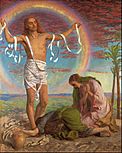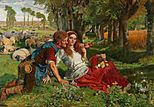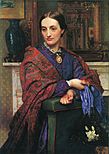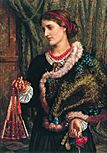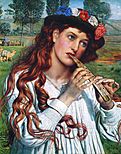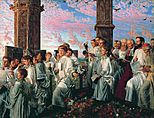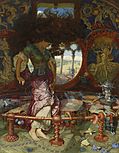William Holman Hunt facts for kids
Quick facts for kids
William Holman Hunt
|
|
|---|---|

Self-portrait, 1867, Galleria degli Uffizi, Florence
|
|
| Born |
William Holman Hunt
2 April 1827 London, England
|
| Died | 7 September 1910 (aged 83) London, England
|
| Occupation | painter |
| Movement | Orientalist; Pre-Raphaelites |
| Spouse(s) | Fanny Waugh Edith Waugh |
| Signature | |
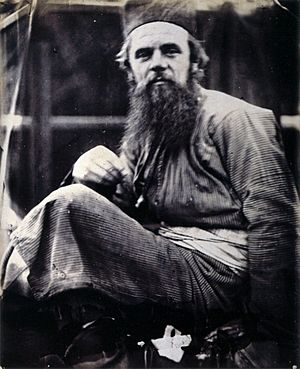
William Holman Hunt (born April 2, 1827 – died September 7, 1910) was a famous English painter. He was one of the people who started the Pre-Raphaelite Brotherhood.
His paintings are known for their incredible detail, bright colors, and deep symbolism. He believed that artists should show the hidden meanings in the world around us. Hunt was one of the most dedicated members of the Pre-Raphaelite Brotherhood and stuck to their ideas throughout his life. He always wanted his art to be seen and loved by many people.
Biography
William Holman Hunt was born in Cheapside, City of London. His birth name was William Hobman Hunt. He later changed it to "Holman" because a clerk misspelled his name when he was baptized.
Hunt wanted to study art at the Royal Academy of Arts. He was turned down at first but eventually got in. Once there, he didn't like the traditional art ideas taught by its founder, Sir Joshua Reynolds.
In 1848, Hunt met another artist and poet named Dante Gabriel Rossetti. Together with John Everett Millais, they started the Pre-Raphaelite Brotherhood. They wanted to make art new and exciting again. They believed in painting things exactly as they saw them in nature, with great care and truth. They were inspired by the spiritual feeling of medieval art and didn't like the more "perfect" style of Renaissance artists like Raphael.
Hunt got married twice. First, he married Fanny Waugh in 1861. Sadly, Fanny died in Italy in 1866 while giving birth. Hunt carved her tombstone himself. Later, he married Fanny's younger sister, Edith. At that time, it was not allowed in Great Britain to marry your deceased wife's sister. So, they traveled to Switzerland and got married there in 1875. This caused some problems with other family members.
At first, people didn't like Hunt's paintings very much. They were criticized for looking a bit awkward or ugly. But he soon became known for his realistic scenes of everyday life, like The Hireling Shepherd and The Awakening Conscience.
However, he became most famous for his religious paintings. One of his most well-known works is The Light of the World (1851–1853). A later version of this painting (from 1900) traveled around the world and is now in St Paul's Cathedral in London.
In the mid-1850s, Hunt traveled to the Holy Land (the Middle East). He wanted to find real places and people to make his religious paintings more accurate. He hoped to make "Jesus Christ’s history and teaching" feel more real to people. While there, he painted famous works like The Scapegoat, The Finding of the Saviour in the Temple, and The Shadow of Death. He also painted many landscapes of the area. Hunt also created paintings based on poems, such as Isabella and The Lady of Shalott. He even built his own house in Jerusalem.
Towards the end of his life, Hunt had to stop painting because his eyesight got very bad. He couldn't achieve the detailed quality he wanted anymore. His last big paintings, including a large version of The Light of the World in St Paul's Cathedral, were finished with help from his assistant, Edward Robert Hughes.
William Holman Hunt passed away on September 7, 1910, and was buried in St Paul's Cathedral in London.
Awards and Recognition
In 1905, Hunt wrote a book about his life. He also tried to explain the meaning of his artworks in his later writings. That same year, King Edward VII gave him a special award called the Order of Merit. This award is given to people who have done great things.
Hunt's personal life was also written about in a book called My Grandfather, his Life and Loves by Diana Holman-Hunt.
The Pre-Raphaelite Brotherhood has been shown in two BBC TV shows. One was The Love School in 1975, where Bernard Lloyd played Hunt. The other was Desperate Romantics, where Rafe Spall played him.
Near Mar Elias Monastery, there is a stone bench put there by Hunt's wife. Hunt painted some of his most important works at that spot. The bench has Bible verses carved into it in Hebrew, Greek, Arabic, and English.
Famous Works
- A Converted British Family Sheltering a Christian Missionary from the Persecution of the Druids (1850)
- Valentine Rescuing Sylvia from Proteus (1851)
- The Awakening Conscience (1853)
- The Light of the World (1854)
- The Scapegoat (1856)
- The Finding of the Saviour in the Temple (1860)
- The Shadow of Death (1871)
- The Importunate Neighbour (1895)
- The Miracle of the Holy Fire (1899)
Gallery
See also
 In Spanish: William Holman Hunt para niños
In Spanish: William Holman Hunt para niños
- English school of painting
- List of Pre-Raphaelite paintings
- List of Orientalist artists
- Orientalism




